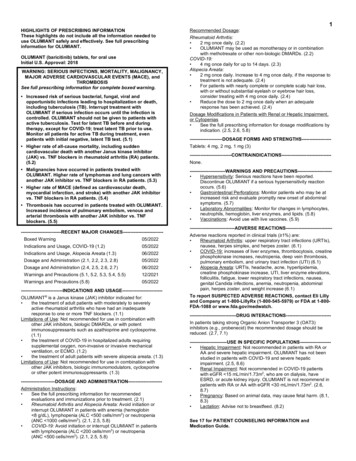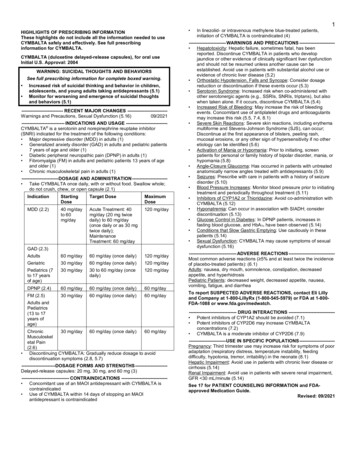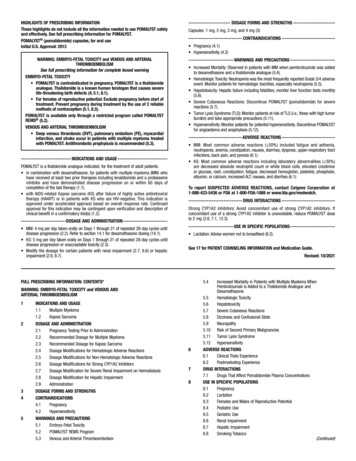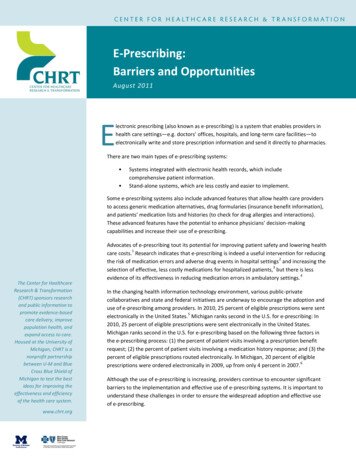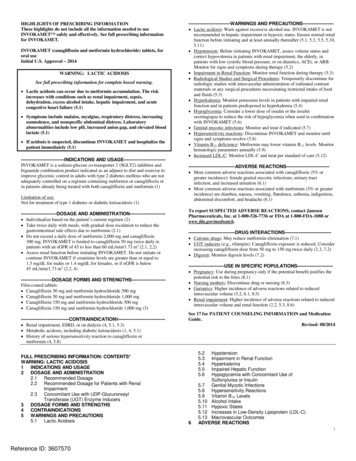
Transcription
HIGHLIGHTS OF PRESCRIBING INFORMATIONThese highlights do not include all the information needed to useINVOKAMET safely and effectively. See full prescribing informationfor INVOKAMET.INVOKAMET (canagliflozin and metformin hydrochloride) tablets, fororal useInitial U.S. Approval – 2014WARNING: LACTIC ACIDOSISSee full prescribing information for complete boxed warning. Lactic acidosis can occur due to metformin accumulation. The riskincreases with conditions such as renal impairment, sepsis,dehydration, excess alcohol intake, hepatic impairment, and acutecongestive heart failure (5.1) Symptoms include malaise, myalgias, respiratory distress, increasingsomnolence, and nonspecific abdominal distress. Laboratoryabnormalities include low pH, increased anion gap, and elevated bloodlactate (5.1) If acidosis is suspected, discontinue INVOKAMET and hospitalize thepatient immediately (5.1)----------------------------INDICATIONS AND USAGE-------------------------- INVOKAMET is a sodium-glucose co-transporter 2 (SGLT2) inhibitor andbiguanide combination product indicated as an adjunct to diet and exercise toimprove glycemic control in adults with type 2 diabetes mellitus who are notadequately controlled on a regimen containing metformin or canagliflozin orin patients already being treated with both canagliflozin and metformin (1)Limitation of use:Not for treatment of type 1 diabetes or diabetic ketoacidosis (1)-----------------------DOSAGE AND ADMINISTRATION---------------------- Individualize based on the patient’s current regimen (2) Take twice daily with meals, with gradual dose escalation to reduce thegastrointestinal side effects due to metformin (2.1) Do not exceed a daily dose of metformin 2,000 mg and canagliflozin300 mg; INVOKAMET is limited to canagliflozin 50 mg twice daily inpatients with an eGFR of 45 to less than 60 mL/min/1.73 m2 (2.1, 2.2) Assess renal function before initiating INVOKAMET. Do not initiate orcontinue INVOKAMET if creatinine levels are greater than or equal to1.5 mg/dL for males or 1.4 mg/dL for females, or if eGFR is below45 mL/min/1.73 m2 (2.2, 4)--------------------DOSAGE FORMS AND STRENGTHS--------------------- Film-coated tablets: Canagliflozin 50 mg and metformin hydrochloride 500 mg Canagliflozin 50 mg and metformin hydrochloride 1,000 mg Canagliflozin 150 mg and metformin hydrochloride 500 mg Canagliflozin 150 mg and metformin hydrochloride 1,000 mg S----------------------------- Renal impairment, ESRD, or on dialysis (4, 5.1, 5.3) Metabolic acidosis, including diabetic ketoacidosis (1, 4, 5.1) History of serious hypersensitivity reaction to canagliflozin ormetformin (4, 5.8)FULL PRESCRIBING INFORMATION: CONTENTS*WARNING: LACTIC ACIDOSIS1INDICATIONS AND USAGE2DOSAGE AND ADMINISTRATION2.1 Recommended Dosage2.2 Recommended Dosage for Patients with RenalImpairment2.3 Concomitant Use with UDP-GlucuronosylTransferase (UGT) Enzyme Inducers3DOSAGE FORMS AND STRENGTHS4CONTRAINDICATIONS5WARNINGS AND PRECAUTIONS5.1 Lactic Acidosis---------------------------WARNINGS AND PRECAUTIONS------------------- Lactic acidosis: Warn against excessive alcohol use. INVOKAMET is notrecommended in hepatic impairment or hypoxic states. Ensure normal renalfunction before initiating and at least annually thereafter (5.1, 5.3, 5.5, 5.10,5.11) Hypotension: Before initiating INVOKAMET, assess volume status andcorrect hypovolemia in patients with renal impairment, the elderly, inpatients with low systolic blood pressure, or on diuretics, ACEi, or ARB.Monitor for signs and symptoms during therapy (5.2) Impairment in Renal Function: Monitor renal function during therapy (5.3) Radiological Studies and Surgical Procedures: Temporarily discontinue forradiologic studies with intravascular administration of iodinated contrastmaterials or any surgical procedures necessitating restricted intake of foodand fluids (5.3) Hyperkalemia: Monitor potassium levels in patients with impaired renalfunction and in patients predisposed to hyperkalemia (5.4) Hypoglycemia: Consider a lower dose of insulin or the insulinsecretagogue to reduce the risk of hypoglycemia when used in combinationwith INVOKAMET (5.6) Genital mycotic infections: Monitor and treat if indicated (5.7) Hypersensitivity reactions: Discontinue INVOKAMET and monitor untilsigns and symptoms resolve (5.8) Vitamin B 12 deficiency: Metformin may lower vitamin B 12 levels. Monitorhematologic parameters annually (5.9) Increased LDL-C: Monitor LDL-C and treat per standard of care (5.12)------------------------------ADVERSE REACTIONS--------------------------- Most common adverse reactions associated with canagliflozin (5% orgreater incidence): female genital mycotic infections, urinary tractinfection, and increased urination (6.1) Most common adverse reactions associated with metformin (5% or greaterincidence) are diarrhea, nausea, vomiting, flatulence, asthenia, indigestion,abdominal discomfort, and headache (6.1)To report SUSPECTED ADVERSE REACTIONS, contact JanssenPharmaceuticals, Inc. at 1-800-526-7736 or FDA at 1-800-FDA-1088 ---DRUG INTERACTIONS----------------------------- Cationic drugs: May reduce metformin elimination (7.1) UGT inducers (e.g., rifampin): Canagliflozin exposure is reduced. Considerincreasing canagliflozin dose from 50 mg to 150 mg twice daily (2.3, 7.2) Digoxin: Monitor digoxin levels (7.2)-----------------------USE IN SPECIFIC POPULATIONS---------------------- Pregnancy: Use during pregnancy only if the potential benefit justifies thepotential risk to the fetus (8.1) Nursing mothers: Discontinue drug or nursing (8.3) Geriatrics: Higher incidence of adverse reactions related to reducedintravascular volume (5.2, 6.1, 8.5) Renal impairment: Higher incidence of adverse reactions related to reducedintravascular volume and renal function (2.2, 5.3, 8.6)See 17 for PATIENT COUNSELING INFORMATION and MedicationGuide.Revised: 08/20145.25.35.45.55.66HypotensionImpairment in Renal FunctionHyperkalemiaImpaired Hepatic FunctionHypoglycemia with Concomitant Use ofSulfonylurea or Insulin5.7 Genital Mycotic Infections5.8 Hypersensitivity Reactions5.9 Vitamin B 12 Levels5.10 Alcohol Intake5.11 Hypoxic States5.12 Increases in Low-Density Lipoprotein (LDL-C)5.13 Macrovascular OutcomesADVERSE REACTIONS1Reference ID: 3607570
78101112136.1 Clinical Studies ExperienceDRUG INTERACTIONS7.1 Drug Interactions with Metformin7.2 Drug Interactions with CanagliflozinUSE IN SPECIFIC POPULATIONS8.1 Pregnancy8.3 Nursing Mothers8.4 Pediatric Use8.5 Geriatric Use8.6 Renal ImpairmentOVERDOSAGEDESCRIPTIONCLINICAL PHARMACOLOGY12.1 Mechanism of Action12.2 Pharmacodynamics12.3 PharmacokineticsNONCLINICAL TOXICOLOGY13.1 Carcinogenesis, Mutagenesis, Impairment ofFertility13.2 Animal Toxicology and/or Pharmacology14 CLINICAL STUDIES14.1 Canagliflozin as Add-on Combination Therapywith Metformin14.2 Canagliflozin Compared to Glimepiride, Both asAdd-on Combination Therapy with Metformin14.3 Canagliflozin as Add-on Combination Therapywith Metformin and Sulfonylurea14.4 Canagliflozin Compared to Sitagliptin, Both asAdd-on Combination Therapy with Metformin andSulfonylurea14.5 Canagliflozin as Add-on Combination Therapywith Metformin and Pioglitazone14.6 Canagliflozin as Add-on Combination Therapywith Insulin (With or Without OtherAnti-Hyperglycemic Agents, Including Metformin)16 HOW SUPPLIED/STORAGE AND HANDLING17 PATIENT COUNSELING INFORMATION* Sections or subsections omitted from the full prescribinginformation are not listed2Reference ID: 3607570
FULL PRESCRIBING INFORMATIONWARNING: LACTIC ACIDOSIS1 Lactic acidosis is a rare but serious complication that can occur due to metforminaccumulation. The risk increases with conditions such as renal impairment, sepsis,dehydration, excess alcohol intake, hepatic impairment, and acute congestive heartfailure. The onset is often subtle, accompanied only by nonspecific symptoms such asmalaise, myalgias, respiratory distress, increasing somnolence, and nonspecificabdominal distress. Laboratory abnormalities include low pH, increased anion gap, and elevated bloodlactate. If lactic acidosis is suspected, INVOKAMET should be discontinued and thepatient hospitalized immediately [see Warnings and Precautions (5.1)].INDICATIONS AND USAGEINVOKAMET (canagliflozin and metformin hydrochloride) is indicated as an adjunct to diet andexercise to improve glycemic control in adults with type 2 diabetes mellitus who are notadequately controlled on a regimen containing metformin or canagliflozin, or in patients who arealready treated with both canagliflozin and metformin [see Clinical Studies (14)].Limitations of UseINVOKAMET is not recommended in patients with type 1 diabetes or for the treatment ofdiabetic ketoacidosis.2 DOSAGE AND ADMINISTRATION2.1 Recommended Dosage Individualize the starting dose of INVOKAMET (canagliflozin and metforminhydrochloride) based on the patient’s current regimen: In patients on metformin, switch to INVOKAMET containing canagliflozin50 mg with a similar total daily dose of metformin; In patients on canagliflozin, switch to INVOKAMET containing metformin500 mg with a similar total daily dose of canagliflozin; In patients already treated with canagliflozin and metformin, switch toINVOKAMET containing the same total daily doses of each component.3Reference ID: 3607570
Take INVOKAMET twice daily with meals, with gradual dose escalation to reduce thegastrointestinal side effects due to metformin [see Dosage Forms and Strengths (3)] . In patients with volume depletion not previously treated with canagliflozin, correct thiscondition before initiating INVOKAMET [see Warnings and Precautions (5.2) andPatient Counseling Information (17)]. Adjust dosing based on effectiveness and tolerability while not exceeding the maximumrecommended daily dose of metformin 2000 mg and canagliflozin 300 mg in patientswith an eGFR of 60 mL/min/1.73 m2 or greater [see Dosage and Administration (2.2)].2.2 Recommended Dosage for Patients with Renal Impairment Assess renal function before initiating INVOKAMET and periodically thereafter. Do not initiate or continue INVOKAMET in patients with serum creatinine levels greaterthan or equal to 1.5 mg/dL for males or 1.4 mg/dL for females. In patients who meetthese serum creatinine levels, do not initiate or continue INVOKAMET if eGFR ispersistently less than 45 mL/min/1.73 m2 [see Contraindications (4) and Warnings andPrecautions (5.3)]. No dose adjustment of INVOKAMET is needed in patients with mild renal impairment(eGFR of 60 mL/min/1.73 m2 or greater). Limit the dose of INVOKAMET to canagliflozin 50 mg twice daily in patients withmoderate renal impairment with an eGFR of 45 to less than 60 mL/min/1.73 m2.2.3Concomitant Use with UDP-Glucuronosyl Transferase (UGT) EnzymeInducersIf an inducer of UGTs (e.g., rifampin, phenytoin, phenobarbital, ritonavir) is co-administeredwith INVOKAMET, consider increasing the dose to canagliflozin 150 mg twice daily in patientscurrently tolerating 50 mg twice daily who have an eGFR of 60 mL/min/1.73 m2 or greater andrequire additional glycemic control [see Drug Interactions (7.2)].Consider another antihyperglycemic agent in patients with an eGFR of 45 to less than60 mL/min/1.73 m2 receiving concurrent therapy with a UGT inducer.3DOSAGE FORMS AND STRENGTHSINVOKAMET (canagliflozin and metformin hydrochloride) film-coated tablets for oraladministration are available in the following strengths: Canagliflozin 50 mg and metformin hydrochloride 500 mg tablets are immediate-release,capsule-shaped, white film-coated tablets with “CM” on one side and “155” on the otherside.4Reference ID: 3607570
4 Canagliflozin 50 mg and metformin hydrochloride 1,000 mg tablets areimmediate-release, capsule-shaped, beige, film-coated tablets with “CM” on one side and“551” on the other side. Canagliflozin 150 mg and metformin hydrochloride 500 mg tablets areimmediate-release, capsule-shaped, yellow, film-coated tablets with “CM” on one sideand “215” on the other side. Canagliflozin 150 mg and metformin hydrochloride 1,000 mg tablets areimmediate-release, capsule-shaped, purple, film-coated tablets with “CM” on one sideand “611” on the other side.CONTRAINDICATIONSINVOKAMET is contraindicated in patients with: Renal impairment (e.g., serum creatinine levels greater than or equal to 1.5 mg/dL formales or 1.4 mg/dL for females, or eGFR is less than 45 mL/min/1.73 m2) which mayalso result from conditions such as cardiovascular collapse (shock), acute myocardialinfarction, and septicemia; end stage renal disease (ESRD) or patients on dialysis [seeWarnings and Precautions (5.1), (5.3) and Use in Specific Populations (8.6)]. Acute or chronic metabolic acidosis, including diabetic ketoacidosis [see Warnings andPrecautions (5.1)]. History of a serious hypersensitivity reaction to canagliflozin or metformin [seeWarnings and Precautions (5.8)].5 WARNINGS AND PRECAUTIONS5.1 Lactic AcidosisLactic acidosis is a rare, but serious, metabolic complication that can occur due to metforminaccumulation during treatment with INVOKAMET and is fatal in approximately 50% of cases.Lactic acidosis may also occur in association with a number of pathophysiologic conditions,including diabetes mellitus, and whenever there is significant tissue hypoperfusion andhypoxemia. Lactic acidosis is characterized by elevated blood lactate levels (greaterthan 5 mmol/L), decreased blood pH, electrolyte disturbances with an increased anion gap, andan increased lactate/pyruvate ratio. When metformin is implicated as the cause of lactic acidosis,metformin plasma levels greater than 5 mcg/mL are generally found.The reported incidence of lactic acidosis in patients receiving metformin is approximately0.03 cases/1000 patient-years (with approximately 0.015 fatal cases/1000 patient-years). In morethan 20,000 patient-years exposure to metformin in clinical trials, there were no reports of lacticacidosis. Reported cases have occurred primarily in diabetic patients with significant renalinsufficiency, including both intrinsic renal disease and renal hypoperfusion, often in the settingof multiple concomitant medical/surgical problems and multiple concomitant medications.Patients with congestive heart failure requiring pharmacologic management, particularly when5Reference ID: 3607570
accompanied by hypoperfusion and hypoxemia due to unstable or acute failure, are at increasedrisk of lactic acidosis.The risk of lactic acidosis increases with the degree of renal dysfunction and the patientʼs age.The risk of lactic acidosis may, therefore, be significantly decreased by regular monitoring ofrenal function in patients taking metformin. In particular, treatment of the elderly should beaccompanied by careful monitoring of renal function. Metformin treatment should not beinitiated in any patients unless measurement of creatinine clearance demonstrates that renalfunction is not reduced. In addition, metformin should be promptly withheld in the presence ofany condition associated with hypoxemia, dehydration, or sepsis.Because impaired hepatic function may significantly limit the ability to clear lactate, metforminshould be avoided in patients with clinical or laboratory evidence of hepatic impairment. Patientsshould be cautioned against excessive alcohol intake when taking metformin, since alcoholpotentiates the effects of metformin on lactate metabolism. In addition, metformin should betemporarily discontinued prior to any intravascular radiocontrast study and for any surgicalprocedure necessitating restricted intake of food or fluids [see Warnings and Precautions (5.3),(5.5), (5.10) and Clinical Pharmacology (12.3)].The onset of lactic acidosis often is subtle, and accompanied by nonspecific symptoms such asmalaise, myalgias, respiratory distress, increasing somnolence, and nonspecific abdominaldistress. More severe acidosis may be associated with signs such as hypothermia, hypotension,and resistant bradyarrhythmias. Patients should be educated to recognize and promptly reportthese symptoms. If present, INVOKAMET should be discontinued until lactic acidosis is ruledout. Gastrointestinal symptoms in patients on a chronic, stable dose of metformin could becaused by lactic acidosis or other serious disease.To rule out lactic acidosis, serum electrolytes, ketones, blood glucose, blood pH, lactate levels,and blood metformin levels may be useful. Levels of fasting venous plasma lactate above theupper limit of normal but less than 5 mmol/L in patients taking metformin do not necessarilyindicate impending lactic acidosis and may be due to other mechanisms, such as poorlycontrolled diabetes or obesity, vigorous physical activity, or technical problems in samplehandling.Lactic acidosis should be suspected in any diabetic patient with metabolic acidosis lackingevidence of ketoacidosis (ketonuria and ketonemia). Lactic acidosis is a medical emergency thatmust be treated in a hospital setting. In a patient with lactic acidosis who is taking metformin, thedrug should be discontinued immediately and general supportive measures promptly instituted.Metformin is dialyzable (clearance of up to 170 mL/min under good hemodynamic conditions)and prompt hemodialysis is recommended to remove the accumulated metformin and correct themetabolic acidosis. Such management often results in prompt reversal of symptoms and recovery[see Boxed Warning and Contraindications (4)].6Reference ID: 3607570
5.2 HypotensionCanagliflozin causes intravascular volume contraction. Symptomatic hypotension can occur afterinitiating INVOKAMET [see Adverse Reactions (6.1)] particularly in patients with eGFR lessthan 60 mL/min/1.73 m2, elderly patients, patients on either diuretics or medications thatinterfere with the renin-angiotensin-aldosterone system (e.g., angiotensin-converting-enzyme[ACE] inhibitors, angiotensin receptor blockers [ARBs]), or patients with low systolic bloodpressure. Before initiating INVOKAMET in patients with one or more of these characteristicswho were not already on canagliflozin, volume status should be assessed and corrected. Monitorfor signs and symptoms after initiating therapy.5.3 Impairment in Renal FunctionCanagliflozin increases serum creatinine and decreases eGFR. Patients with hypovolemia may bemore susceptible to these changes. Renal function abnormalities can occur after initiatingINVOKAMET [see Adverse Reactions (6.1)].Metformin is known to be substantially excreted by the kidney. The risk of metforminaccumulation and lactic acidosis increases with the degree of impairment of renal function.Therefore, INVOKAMET is contraindicated in patients with renal impairment [seeContraindications (4), Warnings and Precautions (5.1), and Use in Specific Populations (8.6)].Before initiation of INVOKAMET therapy and at least annually thereafter, assess renal function[see Contraindications (4)]. In patients in whom development of renal impairment is anticipated(e.g., elderly), assess renal function more frequently and discontinue INVOKAMET if evidenceof renal impairment is present (e.g. serum creatinine levels greater than or equal to 1.5 mg/dL formales or 1.4 mg/dL for females, or eGFR is less than 45 mL/min/1.73 m2).Use of Concomitant Medications That May Affect Renal Function or MetforminDispositionMonitor and adjust dose of INVOKAMET or concomitant drug in patients taking medication(s)that may affect renal function or result in a significant hemodynamic change or interfere with thedisposition of metformin [see Drug Interactions (7.1) and Clinical Pharmacology (12.3)].Radiological Studies and Surgical ProceduresRadiologic studies involving the use of intravascular iodinated contrast materials(e.g., intravenous urogram, intravenous cholangiography, angiography, and computedtomography) can lead to acute alteration of renal function and have been associated with lacticacidosis in patients receiving metformin. Therefore, in patients in whom any such study isplanned, temporarily discontinue INVOKAMET at the time of or prior to the procedure, andwithhold for 48 hours subsequent to the procedure and reinstitute only after renal function hasbeen confirmed to be normal.7Reference ID: 3607570
Temporarily discontinue INVOKAMET for any surgical procedure (except minor procedures notassociated with restricted intake of food and fluids) and restart after the patient’s oral intake hasresumed and renal function has been evaluated as normal.5.4 HyperkalemiaCanagliflozin can lead to hyperkalemia. Patients with moderate renal impairment who are takingmedications that interfere with potassium excretion, such as potassium-sparing diuretics, ormedications that interfere with the renin-angiotensin-aldosterone system are more likely todevelop hyperkalemia [see Adverse Reactions (6.1)].Monitor serum potassium levels periodically after initiating INVOKAMET in patients withimpaired renal function and in patients predisposed to hyperkalemia due to medications or othermedical conditions.5.5Impaired Hepatic FunctionMetformin use in patients with impaired hepatic function has been associated with some cases oflactic acidosis. Therefore, INVOKAMET is not recommended in patients with hepaticimpairment [see Warnings and Precautions (5.1)].5.6Hypoglycemia with Concomitant Use of Sulfonylurea or InsulinCanagliflozinInsulin and insulin secretagogues are known to cause hypoglycemia. Canagliflozin can increasethe risk of hypoglycemia when combined with insulin or an insulin secretagogue [see AdverseReactions (6.1)]. Therefore, a lower dose of insulin or insulin secretagogue may be required tominimize the risk of hypoglycemia when used in combination with INVOKAMET.MetforminHypoglycemia does not occur in patients receiving metformin alone under usual circumstancesof use, but could occur when caloric intake is deficient, when strenuous exercise is notcompensated by caloric supplementation, or during concomitant use with other glucose-loweringagents (such as sulfonylureas and insulin) or ethanol. Elderly, debilitated, or malnourishedpatients, and those with adrenal or pituitary insufficiency or alcohol intoxication, are particularlysusceptible to hypoglycemic effects. Hypoglycemia may be difficult to recognize in the elderly,and in people who are taking beta-adrenergic blocking drugs. Monitor for a need to lower thedose of INVOKAMET to minimize the risk of hypoglycemia in these patients.5.7 Genital Mycotic InfectionsCanagliflozin increases the risk of genital mycotic infections. Patients with a history of genitalmycotic infections and uncircumcised males were more likely to develop genital mycoticinfections [see Adverse Reactions (6.1)]. Monitor and treat appropriately.8Reference ID: 3607570
5.8 Hypersensitivity ReactionsHypersensitivity reactions (e.g., generalized urticaria), some serious, were reported withcanagliflozin treatment; these reactions generally occurred within hours to days after initiatingcanagliflozin. If hypersensitivity reactions occur, discontinue use of INVOKAMET; treat perstandard of care and monitor until signs and symptoms resolve [see Contraindications (4) andAdverse Reactions (6.1)].5.9 Vitamin B12 LevelsIn controlled, 29-week clinical trials of metformin, a decrease to subnormal levels of previouslynormal serum vitamin B 12 levels, without clinical manifestations, was observed in approximately7% of metformin-treated patients. Such decreases, possibly due to interference with B 12absorption from the B 12 -intrinsic factor complex, is, however, very rarely associated with anemiaor neurologic manifestations due to the short duration (less than 1 year) of the clinical trials. Thisrisk may be more relevant to patients receiving long-term treatment with metformin and adversehematologic and neurologic reactions have been reported postmarketing. The decrease in vitaminB 12 levels appears to be rapidly reversible with discontinuation of metformin or vitamin B 12supplementation. Measure hematologic parameters on an annual basis in patients onINVOKAMET and investigate and treat if abnormalities occur. Patients with inadequate vitaminB 12 or calcium intake or absorption may be predisposed to developing subnormal vitamin B 12levels, and routine serum vitamin B 12 measurement at 2- to 3-year intervals is recommended inthese patients.5.10 Alcohol IntakeAlcohol is known to potentiate the effect of metformin on lactate metabolism. Warn patientsagainst excessive alcohol intake while receiving INVOKAMET [see Warnings andPrecautions (5.1)].5.11 Hypoxic StatesCardiovascular collapse (shock) from whatever cause (e.g., acute congestive heart failure, acutemyocardial infarction and other conditions characterized by hypoxemia) have been associatedwith lactic acidosis and may also cause prerenal azotemia. When such events occur, promptlydiscontinue INVOKAMET [see Warnings and Precautions (5.1)].5.12 Increases in Low-Density Lipoprotein (LDL-C)Dose-related increases in LDL-C occur with canagliflozin [see Adverse Reactions (6.1)].Monitor LDL-C and treat per standard of care after initiating INVOKAMET.5.13 Macrovascular OutcomesThere have been no clinical studies establishing conclusive evidence of macrovascular riskreduction with INVOKAMET or any other antidiabetic drug [see Adverse Reactions (6.1)].9Reference ID: 3607570
6ADVERSE REACTIONSThe following adverse reactions are also discussed elsewhere in the labeling: Lactic Acidosis [see Boxed Warning and Warnings and Precautions (5.1), (5.3), (5.5),(5.10), (5.11)] Hypotension [see Warnings and Precautions (5.2)] Impairment in Renal Function [see Warnings and Precautions (5.3)] Hyperkalemia [see Warnings and Precautions (5.4)] Impaired Hepatic Function [see Warnings and Precautions (5.5)] Hypoglycemia with Concomitant Use of Sulfonylurea or Insulin [see Warnings andPrecautions (5.6)] Genital Mycotic Infections [see Warnings and Precautions (5.7)] Hypersensitivity Reactions [see Warnings and Precautions (5.8)] Vitamin B 12 Deficiency [see Warnings and Precautions (5.9)] Increases in Low-Density Lipoprotein (LDL-C) [see Warnings and Precautions (5.12)]6.1 Clinical Studies ExperienceBecause clinical trials are conducted under widely varying conditions, adverse reaction ratesobserved in the clinical trials of a drug cannot be directly compared to the rates in the clinicaltrials of another drug and may not reflect the rates observed in clinical practice.Pool of Placebo-Controlled TrialsCanagliflozinThe data in Table 1 is derived from four 26-week placebo-controlled trials. In one trialcanagliflozin was used as monotherapy and in three trials canagliflozin was used as add-ontherapy with metformin (with or without other agents) [see Clinical Studies (14)]. These datareflect exposure of 1667 patients to canagliflozin and a mean duration of exposure tocanagliflozin of 24 weeks with 1275 subjects exposed to a combination of canagliflozin andmetformin. Patients received canagliflozin 100 mg (N 833), canagliflozin 300 mg (N 834) orplacebo (N 646) once daily. The mean daily dose of metformin was 2138 mg (SD 337.3) for the1275 subjects in the three placebo-controlled metformin add-on studies. The mean age of thepopulation was 56 years and 2% were older than 75 years of age. Fifty percent (50%) of thepopulation was male and 72% were Caucasian, 12% were Asian, and 5% were Black or AfricanAmerican. At baseline the population had diabetes for an average of 7.3 years, had a meanHbA1C of 8.0% and 20% had established microvascular complications of diabetes. Baselinerenal function was normal or mildly impaired (mean eGFR 88 mL/min/1.73 m2).10Reference ID: 3607570
Table 1 shows common adverse reactions associated with the use of canagliflozin. These adversereactions were not present at baseline, occurred more commonly on canagliflozin than onplacebo, and occurred in at least 2% of patients treated with either canagliflozin 100 mg orcanagliflozin 300 mg.Table 1:Adverse Reactions From Pool of Four 26 Week Placebo-Controlled Studies Reported in 2%of Canagliflozin-Treated Patients*CanagliflozinCanagliflozinPlacebo100 mg300 mgAdverse ReactionN 646N 833N 834Female genital mycotic infections†3.2%10.4%11.4%Urinary tract infections‡4.0%5.9%4.3%Increased urination§0.8%5.3%4.6%Male genital mycotic infections¶0.6%4.2%3.7%Vulvovaginal n0.9%1.8%2.3%Nausea1.5%2.2%2.3%* The four placebo-controlled trials included one monotherapy trial and three add-on combination trials withmetformin, metformin and sulfonylurea, or metformin and pioglitazone.†Female genital mycotic infections include the following adverse reactions: Vulvovaginal candidiasis, Vulvovaginalmycotic infection, Vulvovaginitis, Vaginal infection, Vulvitis, and Genital infection fungal. Percentages calculatedwith the number of female subjects in each group as denominator: placebo (N 312), canagliflozin 100 mg(N 425), and canagliflozin 300 mg (N 430).‡Urinary tract infections include the following adverse reactions: Urinary tract infection, Cystitis, Kidney infection,and Urosepsis.§Increased urination includes the following adverse reactions: Polyuria, Pollakiuria, Urine output increased,Micturition urgency, and Nocturia.¶Male genital mycotic infections include the following adverse reactions: Balanitis or Balanoposthitis, Balanitiscandida, and Genital infection fungal. Percentages calculated with the number of male subjects in each group asdenominator: placebo (N 334), canagliflozin 100 mg (N 408), and canagliflozin 300 mg (N 404).#Thirst includes the following adverse reactions: Thirst, Dry mouth, and Polydipsia.Abdominal pain was also more commonly reported in patients taking canagliflozin 100 mg(1.8%), 300 mg (1.7%) than in patients taking placebo (0.8%).Canagliflozin and MetforminThe incidence and type of adverse reactions in the three 26-week pl
300 mg; INVOKAMET is limited to canagliflozin 50 mg twice daily in patients with an eGFR of 45 to less than 60 mL/min/1.73 m (2.1, 2.2) Assess renal function before initiating INVOKAMET. Do not initiate or continue INVOKAMET if creatinine levels are greater than or equal to 1.5 . mg/dL for males or 1.4 mg/dL for females, or if eGFR is below


